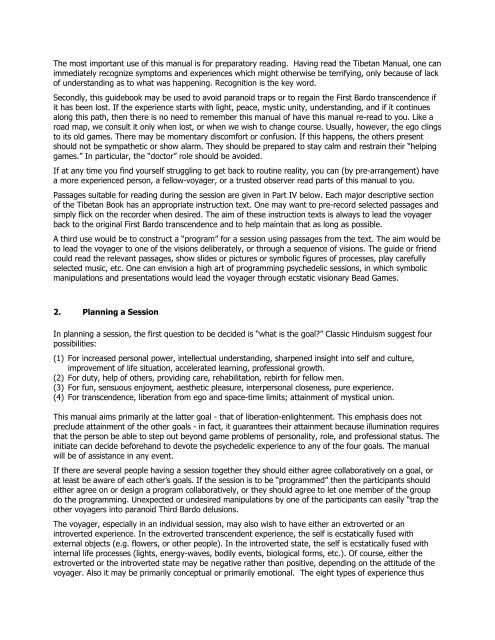Timothy-Leary-The-Psychedelic-Experience-The-Tibetan-Book-Of-The-Dead
Timothy-Leary-The-Psychedelic-Experience-The-Tibetan-Book-Of-The-Dead
Timothy-Leary-The-Psychedelic-Experience-The-Tibetan-Book-Of-The-Dead
You also want an ePaper? Increase the reach of your titles
YUMPU automatically turns print PDFs into web optimized ePapers that Google loves.
<strong>The</strong> most important use of this manual is for preparatory reading. Having read the <strong>Tibetan</strong> Manual, one can<br />
immediately recognize symptoms and experiences which might otherwise be terrifying, only because of lack<br />
of understanding as to what was happening. Recognition is the key word.<br />
Secondly, this guidebook may be used to avoid paranoid traps or to regain the First Bardo transcendence if<br />
it has been lost. If the experience starts with light, peace, mystic unity, understanding, and if it continues<br />
along this path, then there is no need to remember this manual of have this manual re-read to you. Like a<br />
road map, we consult it only when lost, or when we wish to change course. Usually, however, the ego clings<br />
to its old games. <strong>The</strong>re may be momentary discomfort or confusion. If this happens, the others present<br />
should not be sympathetic or show alarm. <strong>The</strong>y should be prepared to stay calm and restrain their “helping<br />
games.” In particular, the “doctor” role should be avoided.<br />
If at any time you find yourself struggling to get back to routine reality, you can (by pre-arrangement) have<br />
a more experienced person, a fellow-voyager, or a trusted observer read parts of this manual to you.<br />
Passages suitable for reading during the session are given in Part IV below. Each major descriptive section<br />
of the <strong>Tibetan</strong> <strong>Book</strong> has an appropriate instruction text. One may want to pre-record selected passages and<br />
simply flick on the recorder when desired. <strong>The</strong> aim of these instruction texts is always to lead the voyager<br />
back to the original First Bardo transcendence and to help maintain that as long as possible.<br />
A third use would be to construct a “program” for a session using passages from the text. <strong>The</strong> aim would be<br />
to lead the voyager to one of the visions deliberately, or through a sequence of visions. <strong>The</strong> guide or friend<br />
could read the relevant passages, show slides or pictures or symbolic figures of processes, play carefully<br />
selected music, etc. One can envision a high art of programming psychedelic sessions, in which symbolic<br />
manipulations and presentations would lead the voyager through ecstatic visionary Bead Games.<br />
2. Planning a Session<br />
In planning a session, the first question to be decided is “what is the goal?” Classic Hinduism suggest four<br />
possibilities:<br />
(1) For increased personal power, intellectual understanding, sharpened insight into self and culture,<br />
improvement of life situation, accelerated learning, professional growth.<br />
(2) For duty, help of others, providing care, rehabilitation, rebirth for fellow men.<br />
(3) For fun, sensuous enjoyment, aesthetic pleasure, interpersonal closeness, pure experience.<br />
(4) For transcendence, liberation from ego and space-time limits; attainment of mystical union.<br />
This manual aims primarily at the latter goal - that of liberation-enlightenment. This emphasis does not<br />
preclude attainment of the other goals - in fact, it guarantees their attainment because illumination requires<br />
that the person be able to step out beyond game problems of personality, role, and professional status. <strong>The</strong><br />
initiate can decide beforehand to devote the psychedelic experience to any of the four goals. <strong>The</strong> manual<br />
will be of assistance in any event.<br />
If there are several people having a session together they should either agree collaboratively on a goal, or<br />
at least be aware of each other’s goals. If the session is to be “programmed” then the participants should<br />
either agree on or design a program collaboratively, or they should agree to let one member of the group<br />
do the programming. Unexpected or undesired manipulations by one of the participants can easily “trap the<br />
other voyagers into paranoid Third Bardo delusions.<br />
<strong>The</strong> voyager, especially in an individual session, may also wish to have either an extroverted or an<br />
introverted experience. In the extroverted transcendent experience, the self is ecstatically fused with<br />
external objects (e.g. flowers, or other people). In the introverted state, the self is ecstatically fused with<br />
internal life processes (lights, energy-waves, bodily events, biological forms, etc.). <strong>Of</strong> course, either the<br />
extroverted or the introverted state may be negative rather than positive, depending on the attitude of the<br />
voyager. Also it may be primarily conceptual or primarily emotional. <strong>The</strong> eight types of experience thus


